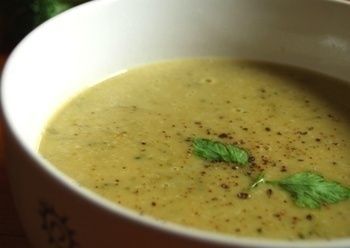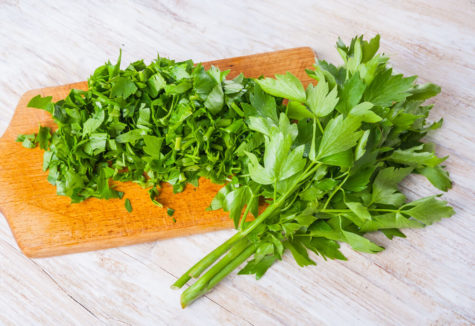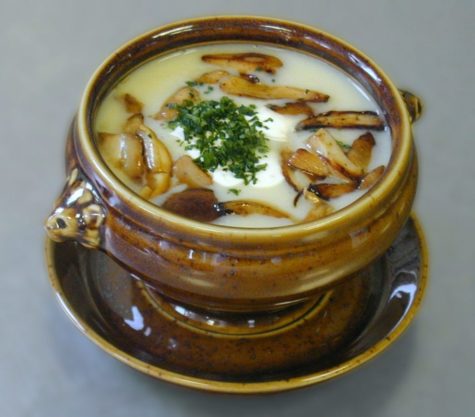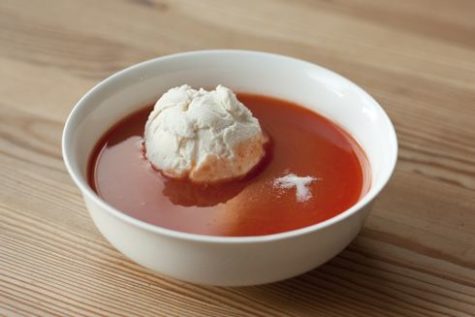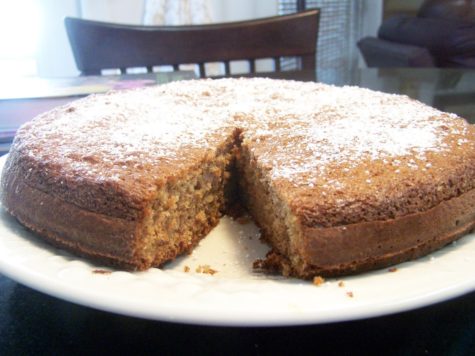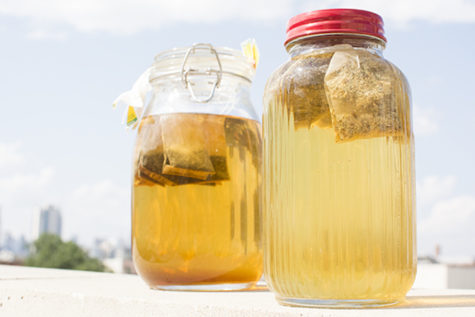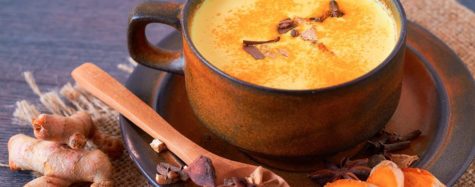Recipes
Cream of Alexanders Soup
- 3 tablespoons salted butter
- 1 onion, finely chopped
- 1 clove garlic, minced
- 450 g Alexanders stems and leaves
- 1 Ltr vegetable stock
- 1 tablespoon chopped fresh parsley
- 1/2 tablespoon chopped fresh chervil
- Salt and pepper, to taste
- 150 ml single cream
Melt the butter in a saucepan over medium heat. Add the onion and garlic, cook and stir until soft. Add the Alexanders stems and leaves, toss and coat in the butter, onion and garlic. Cook for 2 minutes. Add the rest of the herbs and stir in the salt and pepper.
Pour in the vegetable stock, and simmer gently over a low heat for an hour. Right before serving, stir in the cream and blend the soup to a smooth consistency with a hand held liquidizer or food processor. Serve immediately in warm bowls.
About Alexanders:
Alexanders is native to the Mediterranean but is able to thrive farther north. It was a highly popular herb during the time of Alexander the Great. The Romans called it the ‘pot herb of Alexandria.’
Alexanders was a traditional plant for cleansing the blood and a digestive herb for strengthening the stomach. Seafarers used it to treat scurvy and herbalists used it to relieve stomach and urinary problems. An in depth look at Alexanders can be found in the Encyclopedia of Herbology.
Recipe: Health Benefits Times
Alexanders Seed Bread

A simple, lightly spiced bread which is perfect with savory accompaniments.
- 1 heaped tbsp Alexanders seeds
- 500 g white or wholemeal flour (or half and half)
- Pinch of sea salt
- 1 tsp quick yeast
- 1 tsp sugar or honey
- 400 ml warm water
- 15 ml olive oil (optional)
Roughly grind or chop (you want some texture, not a powder) the Alexanders seeds in a seed grinder or pestle and mortar. You may find them easier to grind if you dry roast them first (140°C for 10-20 minutes), making sure they don’t burn.
Mix the flour, ground seeds and salt in a large bowl. Dissolve the yeast and honey in the warm water and stir into the mix. Combine well and knead the dough for 10 minutes, or until it starts to bounce back. Cover and leave in a warm place until it doubles in size.
When well risen, oil a bread tin, punch the dough a couple of times then place in the oiled tin, cover and allow to rise to double the size again. Heat the oven to 200°C and bake for 40-45 minutes, or until hollow-sounding when tapped.
Remove from the oven and leave to sit for 10 minutes before attempting to take the loaf out of the tin. Allow to cool on a wire rack before slicing.
About Alexanders:
Alexanders is native to the Mediterranean but is able to thrive farther north. It was a highly popular herb during the time of Alexander the Great. The Romans called it the ‘pot herb of Alexandria.’
Alexanders was a traditional plant for cleansing the blood and a digestive herb for strengthening the stomach. Seafarers used it to treat scurvy and herbalists used it to relieve stomach and urinary problems. An in depth look at Alexanders can be found in the Encyclopedia of Herbology.
Recipe: Rachel Lambert
Lovage Vegetarian Stock
Lovage is an ancient healing herb, mostly used for its diuretic properties in cases of water retention and urinary difficulties, and also for pain and swelling (inflammation) of the lower urinary tract, for preventing of kidney stones, and to increase the flow of urine during urinary tract infections.
The seeds, leaves and leaf stems have a strong, earthy, celery flavor that enriches soups and stews and is particularly useful in vegetarian dishes, with rice, vegetable stuffings and nut roasts.
Here is a recipe for a vegetarian stock.
- 4 c. washed lovage leaves
- 6 c. water
- freshly ground pepper.
Simmer about 10 minutes. Use in soups, sauces and stews. Can be frozen.
Lovage and Potato Soup
- 1 ounce butter
- 2 medium onions, finely chopped
- 4 tablespoons lovage leaves, finely chopped
- 3 tablespoons all-purpose flour
- 2 cups chicken broth
- 1 cup milk or heavy cream
- 2 or 3 chopped potatoes
- Salt and white pepper to taste
Directions
Melt butter in a saucepan and gently sauté the onions for 5 minutes or until tender. Add the lovage
Whisk in the flour and cook at medium heat for one minute, stirring constantly.
Gradually whisk in the broth, add potatoes, cover and simmer gently for 15 minutes or until potatoes are tender.
Add the milk, salt, and pepper, bring to a gentle simmer. Do not boil the soup or it will curdle.
You can add carrots or other veggies as you like; just increase the liquid amount (either the broth or the milk) until you reach your desired consistency. If you’re not feeling well, add garlic.
Note:
Although I was told that lovage does not dry well, I have not found that to be the case. I dry the leaves as I would any other plant and put them in airtight glass jars. I later crush or powder them and use when needed for flavoring. The leaves should be removed from the stems prior to drying or they will turn yellow. I try to harvest my leaves before they flower. As with other plants, they will become a bit bitter after flowering.
Source: The Herbal Academy
Wild Rose Blossom Ice Cream
Any fragrant edible blossom will do, so long as it is abundant.
- 100 ml full fat milk
- 200 ml double cream
- 4 cups wild rose blossoms
- 1 tsp vanilla essence
- 2 egg yolks
- 30 grams caster sugar
Pour the milk and cream into a saucepan with the blossoms and vanilla essence. Heat the mixture until it begins to simmer. Remove, put to one side and let steep for 30 minutes. Strain out the blossoms.
Whisk the egg yolks with the sugar until creamy. Then gently pour the cream mixture onto the yolks, whisking all the while. Return the mixture to the saucepan and heat for a minute or two to thicken.
Pour into an ice-cream machine, if you have one, and churn. Otherwise, pour the ice cream into a bowl and freeze. Stir often until it resembles ice cream.
From: Foraging by John Lewis-Stempel
Nyponsoppa – Rose Hip Soup
This Swedish soup, blood red in color, is traditionally served as pudding.
- 600 ml Rose hips
- 2.6 litres water
- 3 tbsp potato flour
- 100 grams sugar
- 4 tsp ground almonds
Rinse the Rose hips and place them in a heavy bottomed saucepan with the water, and bring to a boil. Simmer, stirring occasionally, until the hips are soft – about 20 to 30 minutes.
Blend the hip pulp in a mixer and pass through a fine sieve or jelly bag, returning the liquid to the saucepan. Stir the potato flour into a little cold water, then add to the saucepan, along with the sugar.
Bring to a boil again. Turn down the heat, and let the soup cool. Serve with ground almonds on top. Macaroons and ice cream are also familiar floats in Nyponsoppa.
Serves 4
From: Foraging by John Lewis-Stempel
Gluten-Free Honey Almond Cake
Super simple, moist and delicious almond meal and honey cake! This cake is gluten free and paleo friendly. Feel free to change up the flavors (see notes on how to do so). I think a lemon blueberry version would be delicious.
Ingredients:
- 2 cups (8 ounces) almond flour or almond meal, firmly packed into measuring cups
- 1 teaspoon baking powder
- ½ teaspoon baking soda
- ½ teaspoon ground cardamom
- ½ teaspoon ground ginger
- ½ teaspoon fine-grain sea salt
- 4 eggs, beaten
- ⅔ cup + 1 teaspoon honey, divided
- ¼ cup extra-virgin olive oil
- One orange, preferably organic
- 6 ounces raspberries, preferably organic
Garnish:
- Sprinkle of powdered sugar (optional)
- ½ cup chopped raw pistachios
Instructions:
Preheat the oven to 325 degrees Fahrenheit. Grease a 9-inch pan (I used a springform pan) with butter and dust with almond flour/meal.
In a large mixing bowl, whisk together the almond meal, baking powder, baking soda, cardamom, ginger and sea salt.
In another bowl, combine the beaten eggs, honey, olive oil and the zest of your orange. Use a whisk to mix well. Pour the wet ingredients into the dry. Stir just until there are a few clumps remaining, then gently fold in the raspberries.
Pour the mixture into your prepared pan.
Bake for 40 to 45 minutes, until the cake is golden brown and the center is firm to the touch. Place the cake on a wire rack to cool to room temperature.
Once the cake is out of the oven, slice your orange in half and squeeze out ¼ cup juice. Combine the juice with 1 teaspoon honey in a small saucepan. Warm over medium heat, while stirring, just until the honey is blended into the juice. Brush the orange-honey glaze over the warm cake. It should soak right in.
Once the cake is cool, use a sharp knife to slice into 8 pieces. Transfer each piece to a plate, sprinkle with powdered sugar (optional) and finish with a sprinkle of chopped pistachios.
Notes:
Store this cake in the refrigerator, covered, for longevity. Those juicy berries make this cake more quick to spoil at room temperature.
Substitute an equal amount of other berries or fresh fruit for the raspberries and/or trade lemon or lime zest for the orange zest and/or garnish with fruit instead of powdered sugar and pistachios. If you omit the fruit completely, the cake will be done somewhere around 35-40 minutes. If you add additional fruit, you’ll need to bake longer.
Found at: Cookie and Kate
Sun Tea
A great way to make some tea without heating up your kitchen is to use the power of the sun to make sun tea.
Here’s how:
Put 4 to 8 tea bags into a clean 2 quart or gallon glass container (4 teabags for a 2 quart container, 8 tea bags for a gallon container). Fill with water and cap. Place outside where the sunlight can strike the container for about 3 to 5 hours. Move the container if necessary to keep it in the sun. When the tea has reached its desired strength, remove from sun and put it in the refrigerator. You may or may not want to remove the tea bags at this point.
The tea will probably taste more mellow than what you are used to from using boiling water. The slow steeping has a way of bringing out a slightly different flavor from the tea. Also, because you didn’t use boiling water, you should refrigerate the tea and drink it up pretty quickly – a day or two. It will not keep as well as iced tea made from boiling water.
Found at: Simply Recipes
Cinnamon Turmeric Tea
Here is a recipe for Cinnamon Turmeric Tea to flush inflammation naturally.
Inflammation has been found to be the root of most diseases and ailments, so it is of high importance to fight it and thus improve overall health. The combination of cinnamon and turmeric is one of the most delicious and powerful natural ways to fight inflammation in the body.
These spices are inexpensive, calorie-free and easy to find in most supermarkets and natural foods stores. Because turmeric and cinnamon are safe with no side effects, they may be worth a try for their potential health benefits. Keep in mind that ground spices release flavor more slowly than whole spices.”
Green tea, is a rich source of polyphenols, that fight free radicals and prevent chronic diseases. Green tea regulates blood sugar, helps weight loss, fights inflammation in the gut, and lowers bad cholesterol while increasing good cholesterol. Also, it boosts liver health and the cognitive function, helps weight loss, and lowers risk of heart disease.
Here is how to prepare this miraculous drink:
Cinnamon Turmeric Iced Tea Recipe
Ingredients:
- 1/4 tsp. cinnamon
- 1/8 tsp. turmeric
- 1-2 Tbsp. black or green loose leaf tea
- 1 tsp honey
- lemon slices, optional
Instructions:
Add the ingredients to the bottom of a French press, add hot water to about the halfway point, and leave to steep for 5 minutes. Stir once press and leave the mixture to cool.
Pour the tea in a mug, and add the lemon slices. Enjoy and naturally fight inflammation in the body!
Source: Healthy Food House
Moon Milk
In Ayurveda (one of the oldest systems of natural healing in the world), warm milk is a common remedy for sleeplessness. This recipe features nutmeg (a natural sleep aid) and ashwagandha (an adaptogen that helps your body deal with stress) to shepherd you to dreamland. Look for ashwagandha at health food stores, Indian specialty stores, or Whole Foods.
Ingredients:
- 1 cup whole milk or unsweetened nut milk (such as hemp, almond, or cashew)
- ½ teaspoon ground cinnamon
- ½ teaspoon ground turmeric
- ¼ teaspoon ground ashwagandha (or another adaptogen, like shatavari or astralagus)
- 2 pinches of ground cardamom
- Pinch of ground ginger (optional)
- Pinch of ground nutmeg
- Freshly ground black pepper
- 1 teaspoon virgin coconut oil or ghee
- 1 teaspoon honey, preferably raw
Recipe Preparation:
Bring milk to a simmer in a small saucepan over medium-low heat. Whisk in cinnamon, turmeric, ashwagandha, cardamom, ginger, if using, and nutmeg; season with pepper. Whisk vigorously to incorporate any clumps. Add coconut oil, reduce heat to low, and continue to cook until warmed through, 5–10 minutes (the longer you go, the stronger the medicine). Remove from heat and let cool slightly. Stir in honey (you want to avoid cooking honey or you’ll destroy its healing goodness). Pour into a mug, drink warm, and climb right into bed.
Found at: Bon Appetit
